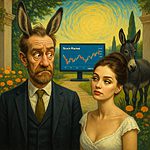
Cognitive Dissonance in Marketing & Investing: When They Lie and You Defend Them
May 27, 2025
What is cognitive dissonance in marketing? The psychological warfare that transforms worthless assets into emotional attachments while decimating your portfolio.
The Manipulation Matrix
Cognitive dissonance isn’t just some dusty psychological concept—it’s the invisible architecture that engineers almost every financial bubble, market mania, and investing disaster in history. When your brain holds two contradictory beliefs simultaneously, it creates unbearable psychological tension. This tension doesn’t resolve toward truth—it resolves toward comfort.
This simple mechanism underlies the most devastating wealth transfers in market history. The professional investor understands cognitive dissonance isn’t an academic curiosity—it’s the primary battlefield where capital changes hands, where the prepared feast on the psychological weaknesses of the unprepared.
The average investor believes they make rational decisions based on information and analysis. The reality? Your positions are psychological compromises—resolutions of cognitive conflicts that prioritise emotional comfort over financial reality. This isn’t a minor inefficiency in your process. It’s the central vulnerability that markets systematically exploit.
The Dissonance Architecture
Markets operate through predictable dissonance patterns that repeat with clockwork precision:
The Commitment-Evidence Gap. Once capital is deployed, your brain distorts incoming information to justify that commitment. This distortion isn’t subtle—research shows investors become physiologically unable to process contradictory data after position establishment. The larger your position, the stronger this filtering mechanism becomes.
The Status-Reality Disconnect. Markets confer status through participation in dominant narratives. When market reality threatens this status, unbearable dissonance forces most participants to preserve status over capital. This explains why investors hold failing positions long after objective evidence demands exit.
The Consistency Compulsion. Your brain pathologically seeks narrative consistency, even at devastating financial cost. When markets present complex, contradictory conditions, cognitive dissonance forces simplification toward whatever narrative preserves your existing mental models, regardless of mounting evidence to the contrary.
The Effort Justification Loop. The more research, time, and emotional energy you invest in a market thesis, the more cognitive dissonance will force you to defend that thesis despite contradictory price action. This creates the paradox where the most thoroughly researched positions often become the most devastating losses.
The Marketing Machine: Engineering Dissonance for Profit
Financial markets are history’s most sophisticated dissonance generation systems. The machinery works with precision:
The narrative begins with core truths, carefully selected to create intellectual buy-in. “Blockchain is a revolutionary technology.” “AI will transform productivity.” “Housing always appreciates long-term.” These statements contain enough factual basis to bypass your initial scepticism filters.
Once this foundation is established, subtle distortions are introduced: “Therefore, this specific blockchain token will appreciate 100x.” “This AI company with no revenues deserves a $100 billion valuation.” “This specific house can’t possibly decline in value.”
The logic gap between the core truth and the specific application creates cognitive dissonance. Rejecting the specific claim feels like rejecting the core truth—a psychologically uncomfortable position. Most investors resolve this dissonance by accepting both propositions rather than parsing the critical differences.
This is when the marketing machine accelerates:
- Social Proof Amplification. As early adopters commit capital, their advocacy creates cascading social validation that overwhelms rational analysis. The resulting FOMO isn’t just emotional weakness—it’s the predictable resolution of cognitive dissonance between “Everyone seems to be profiting” and “I’m not participating.”
- Complexity Obfuscation. Technical language, proprietary metrics, and specialised jargon create artificial complexity that triggers cognitive dissonance between “I don’t fully understand this” and “I’m a sophisticated investor.” This dissonance typically resolves toward unwarranted confidence rather than increased scrutiny.
- Selective Evidence Curation. Information environments become carefully managed to present confirmatory evidence while minimising contradictory data. This creates dissonance between “The overall picture looks positive” and “There are concerning counterarguments.” Most investors resolve this by dismissing contradictory evidence as exceptions rather than warning signals.
- Identity Fusion. The most powerful dissonance manipulation fuses investment theses with personal identity. When rejecting an investment requires rejecting part of your self-concept, cognitive dissonance almost always resolves toward preserving identity over preserving capital.
The Technical Manifestation
Cognitive dissonance creates specific, predictable technical patterns in markets:
Asymmetric Volume Profiles. Dissonance creates characteristic volume distribution where position accumulation occurs across broad price ranges while distribution happens in compressed, high-volume zones. This leaves distinctive footprints on volume profile analysis—wide, diffuse value areas during accumulation phases, followed by sharp, spike-like volume nodes during distribution.
Narrative-Price Divergence. As dissonance strengthens, the gap between narrative intensity and price confirmation widens. This creates measurable divergences between sentiment indicators and price action, typically most extreme at major turning points when cognitive dissonance reaches maximum tension.
Volatility Compression Sequences. Cognitive dissonance manifests technically as decreasing price volatility despite increasing fundamental uncertainty. This creates the famous “calm before the storm” pattern, where market participants collectively suppress volatility through dissonance-driven position defence, creating energy buildup that eventually releases catastrophically.
Time-Frame Distortion. As dissonance intensifies, market participants shift between time frames to maintain their narratives. Long-term investors suddenly become “day traders” when positions move against them; short-term speculators suddenly discover “fundamental value” when trapped in losing trades. This time-frame fluidity creates identifiable technical footprints at key market turning points.
The Institutional Advantage
Professional capital exploits cognitive dissonance with industrial efficiency. Unlike retail investors who experience dissonance as psychological discomfort, institutions weaponise it as a strategic advantage:
- Narrative Construction. Institutions meticulously craft narratives specifically designed to trigger predictable dissonance patterns, creating exploitable retail behaviour.
- Positioning Against Resolution. Once sufficient dissonance is created, positions are established in anticipation of inevitable dissonance resolution, typically through capitulation events that transfer wealth from retail to institutional hands.
- Amplification Through Media. Financial media serves as the primary dissonance delivery system, magnifying contradictions that force psychological resolution through predictable market behaviours.
- Time Arbitrage. Institutions exploit the different time horizons over which cognitive dissonance operates, using longer capital commitment periods to harvest profits from short-term dissonance resolution cycles.
The Self-Awareness Edge
The professional investor doesn’t claim immunity from cognitive dissonance—they build systems specifically designed to counteract it:
Position Sizing Discipline. By limiting position sizes below psychological threshold levels, professionals ensure no single position triggers dissonance-driven decision distortion.
Pre-Commitment Mechanisms. Exit criteria are established before entry, creating binding decision frameworks that function regardless of subsequent dissonance.
Devil’s Advocate Protocols. Systematic exposure to contradictory viewpoints reduces dissonance accumulation that would otherwise distort decision quality.
Identity Separation. Professional capital cultivates deliberate separation between personal identity and market positions, reducing the identity-threat dissonance that destroys retail capital.
Weaponizing Awareness
Understanding cognitive dissonance isn’t enough—you must weaponise this awareness:
- Hunt Dissonance Clusters. Identify market sectors where objective reality and prevailing narratives show maximum divergence. These represent zones where imminent dissonance resolution will create extraordinary profit opportunities.
- Monitor Resolution Triggers. Dissonance maintains equilibrium until specific catalysts force resolution. Identify these potential triggers in advance and position accordingly.
- Track Narrative Evolution. Dissonance creates predictable narrative mutation patterns as contradictions intensify. These mutations provide an early warning of impending dissonance collapse.
- Measure Commitment-Evidence Gaps. Quantify the widening gulf between positioning commitment and supporting evidence across market segments. When this gap reaches extremes, the probability of violent dissonance resolution approaches certainty.
The Current Battlefield
Today’s market presents a master class in cognitive dissonance. We’re witnessing historic divergence between:
- Economic indicators suggest a slowdown, vs. market prices suggest robust growth
- Corporate earnings trajectories vs. current valuations
- Inflation reality vs. rate cut expectations
- Geopolitical risk escalation vs. volatility measures
This divergence isn’t creating anxiety among investors—instead, it’s creating the synthetic comfort that always precedes major dissonance resolution events.
The professional doesn’t predict exactly when this resolution occurs. They simply recognize that the physics of psychological discomfort guarantees it will occur, and position accordingly.
Signal and Application
We stand at a moment of peak dissonance in markets. The gap between narrative and reality has reached levels historically associated with major inflexion points. This creates actionable intelligence:
- Identify Your Dissonance Points. Which positions in your portfolio create the most discomfort when challenged? These represent your maximum vulnerability to dissonance-driven losses.
- Invert Consensus Comfort. What market sectors show maximum comfort despite maximum contradiction? These represent prime hunting grounds for asymmetric opportunities.
- Build Anti-Dissonance Position Architecture. Structure positions with mechanical exit criteria that function regardless of psychological state. Remove discretionary decision-making from high-dissonance scenarios.
- Deploy Contrarian Capital Against Consensus Dissonance. The highest-probability trades exist precisely where collective dissonance is most acute—where market participants must maintain contradictory beliefs to justify current positioning.
Remember: Markets don’t reward intelligence, analysis, or information advantage. They reward psychological self-mastery—the capacity to recognise and counteract the dissonance that distorts every investment decision.
The straw-to-gold alchemists of Wall Street aren’t selling financial products. They’re selling psychological comfort, resolution of the cognitive dissonance they intentionally engineer. Your edge isn’t found in better information, faster execution, or deeper analysis. It’s found in recognising the dissonance patterns that precede every major market dislocation.
The masses will continue buying straw while calling it gold. Your advantage lies in seeing the straw for what it is, positioning accordingly, and maintaining this clarity while others succumb to the comfort of collective delusion.
The market always resolves cognitive dissonance through price. The only question is whether your capital will be transferred or multiplied when this resolution arrives.














